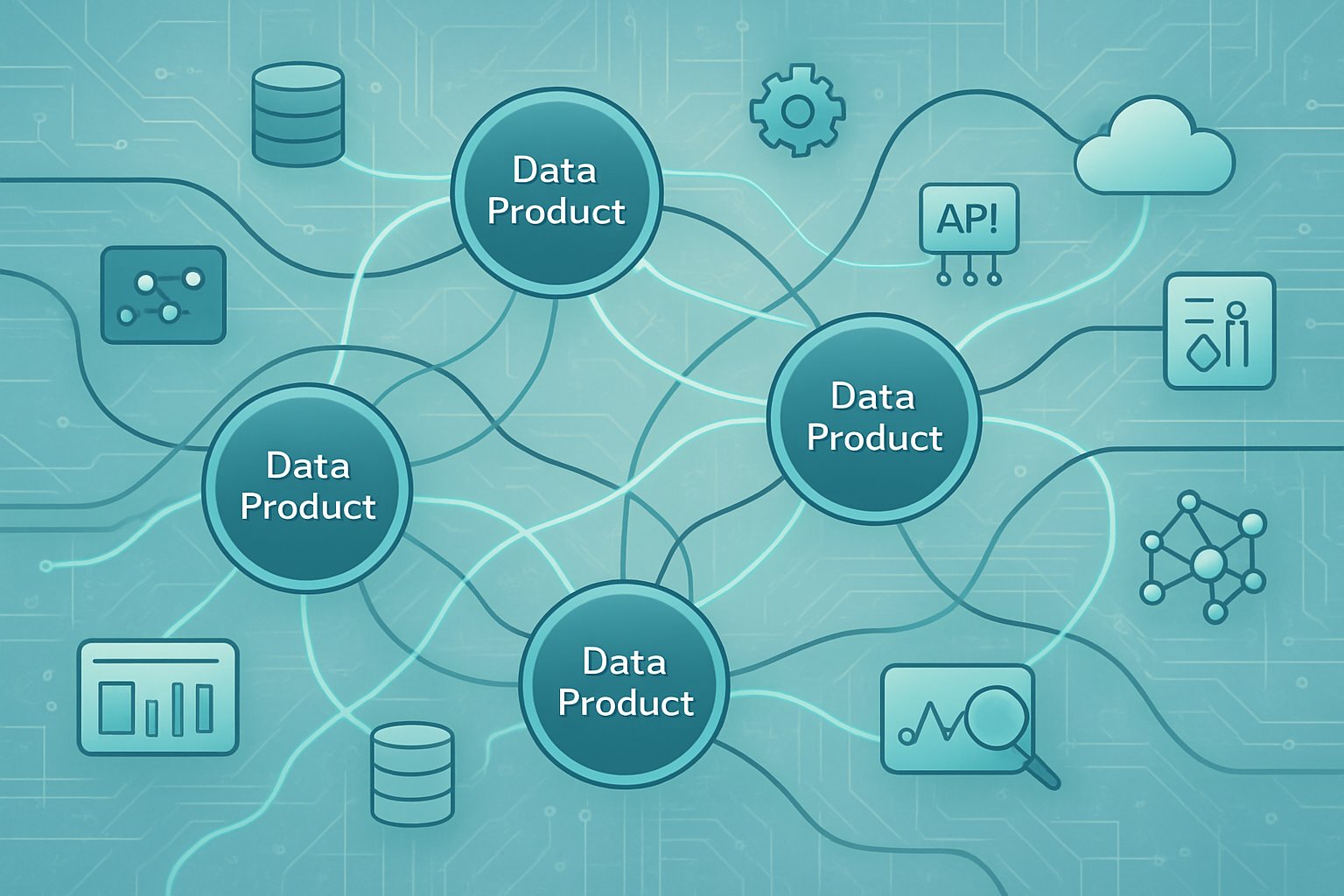Organizations today face a growing challenge: how to turn massive amounts of data into useful products that teams can actually use. Traditional centralized data systems create bottlenecks and slow down decision-making across different departments. Data mesh offers a solution by breaking down these large systems into smaller, manageable pieces that individual teams can own and control.

Data products in a data mesh are autonomous, standardized data units that contain specific datasets designed to meet user needs while maintaining quality and governance standards. Unlike traditional data warehouses where everything sits in one place, data products live close to the teams that create and understand the data best. This approach allows organizations to scale their data operations without creating more complexity.
Successfully implementing data products requires understanding both the technical architecture and organizational changes needed to support this new approach. Teams must learn how to design products that others can easily discover and use, while maintaining data quality and following company-wide rules. The process involves choosing the right tools, setting up proper governance, and managing the transition from old systems to new ones.
Key Takeaways
- Data mesh transforms centralized data systems into distributed, domain-owned data products that reduce bottlenecks and improve team agility
- Successful data product implementation requires careful design, standardization, and governance to ensure quality and usability across the organization
- Organizations need the right architectural foundations, tools, and change management strategies to effectively transition from traditional data systems to a mesh approach
Key Principles of Data Mesh

Data mesh operates on four foundational principles that work together to create a scalable data architecture. These principles shift ownership to domain teams, treat data like products, provide self-service infrastructure, and establish governance frameworks that balance autonomy with organizational standards.
Domain-Oriented Data Ownership
Domain-oriented ownership places data responsibility with teams closest to the business context. Each domain team owns both operational systems and analytical data from their specific business area.
This approach breaks away from centralized data teams. Instead, teams that understand podcast operations own podcast data. Teams managing user accounts control user analytics.
Key ownership responsibilities include:
- Data collection and processing
- Data quality and accuracy
- Data accessibility and documentation
- Ongoing maintenance and updates
Domain teams serve analytical data alongside operational capabilities. A podcast team provides APIs for creating episodes and analytical endpoints for historical listening data.
This model reduces dependency bottlenecks. Teams can release data products without waiting for central data teams. They understand business context better than external teams.
Each domain becomes autonomous in data decisions. Teams choose appropriate storage formats and access patterns. They can respond quickly to changing business needs within their area.
Data as a Product Philosophy
Data as a product treats analytical data like customer-facing products. Domain teams become data product owners responsible for user satisfaction and data quality metrics.
Data products must meet specific usability standards. They need clear documentation, reliable access methods, and consistent quality levels. Users should easily discover and understand available data.
Essential product characteristics:
- Discoverable – Users can find relevant datasets
- Understandable – Clear documentation and metadata
- Trustworthy – Consistent quality and accuracy
- Accessible – Easy-to-use interfaces and APIs
Domain data product owners measure success through user satisfaction scores. They track data quality metrics and consumption lead times. These measures drive continuous improvement.
Data product developers build and maintain these offerings. They work alongside other domain developers. They focus on user needs rather than just technical requirements.
This philosophy inverts traditional responsibility models. Data quality accountability moves upstream to data sources. Teams can’t pass poor data downstream and expect others to fix it.
Self-Service Data Platform
Self-service data platforms provide infrastructure and tools that domain teams need to build data products independently. Teams access high-level abstractions without managing complex underlying systems.
The data platform removes technical barriers to data product creation. Domain teams focus on business logic rather than infrastructure provisioning. They deploy and monitor data products using standardized tools.
Platform capabilities include:
- Data pipeline development and deployment
- Storage and compute resource management
- Monitoring and observability tools
- Security and access control systems
Platform teams maintain shared infrastructure while domain teams retain data ownership. This separation allows specialization in both areas. Platform experts handle technical complexity while domain experts focus on business value.
Teams can provision resources on demand. They don’t wait for infrastructure requests or approval processes. Standardized interfaces ensure consistency across different data products.
The platform extends existing development platforms. It provides data-specific tools alongside traditional application infrastructure. Teams use familiar deployment and monitoring patterns.
Federated Computational Governance
Federated computational governance balances domain autonomy with organizational standards. It establishes global policies while allowing local implementation flexibility.
Governance operates through automated systems rather than manual processes. Policies embed directly into data infrastructure and development tools. Teams can’t accidentally violate standards.
Governance areas include:
- Data security and privacy controls
- Compliance with regulatory requirements
- Data quality standards and metrics
- Interoperability and integration standards
Central governance teams define high-level policies. Domain teams implement these policies within their specific contexts. Technology enforces compliance automatically where possible.
This model scales better than centralized approval processes. Teams move quickly while maintaining necessary controls. Governance becomes enablement rather than gatekeeping.
Computational governance uses code and configuration to enforce rules. Data products inherit security policies from platform templates. Quality checks run automatically in deployment pipelines.
Standards evolve through collaboration between central and domain teams. Governance adapts to new requirements without slowing development velocity.
Defining and Designing Data Products

Creating effective data products requires a structured approach that centers on consumer needs and clear contracts. The process involves mapping out key components, understanding user requirements, and establishing firm agreements about data delivery.
Data Product Canvas
A data product canvas serves as a blueprint for building successful data products. It maps out the essential elements that teams need to consider before development begins.
The canvas starts with defining the target consumers and their specific use cases. Teams identify who will use the data product and how they plan to consume it.
Next, the canvas outlines the data sources and metadata requirements. This includes where data comes from and what information consumers need to understand the data properly.
The canvas also defines the data product architecture. Teams specify how data gets stored, processed, and delivered to users.
Key sections include:
- Consumer personas and use cases
- Data sources and acquisition methods
- Output formats and delivery mechanisms
- Quality standards and service level agreements
- Ownership and governance responsibilities
Identifying Consumer Needs
Understanding consumer needs forms the foundation of effective data product design. Domain teams must gather detailed requirements from potential users before building anything.
Teams conduct interviews with data consumers to learn their specific workflows. They ask about current pain points and desired outcomes from the data product.
Consumer research reveals important details like:
- Required data formats and update frequencies
- Integration needs with existing tools
- Performance expectations and latency requirements
- Security and compliance constraints
Teams also map out different user types and their varying needs. A business analyst might need summarized reports while a data scientist requires raw datasets.
This research directly shapes the data product’s features and capabilities. Teams prioritize development based on the most critical consumer requirements.
Establishing Data Contracts
Data contracts define clear agreements between data producers and consumers. They specify exactly what data gets delivered and how it gets formatted.
A data contract includes the data schema with field names, types, and descriptions. It also covers update schedules and data quality guarantees.
The contract specifies:
- Data structure and field definitions
- Delivery methods and access protocols
- Update frequency and timing
- Quality metrics and error handling
- Versioning and change management procedures
Teams document these contracts in a central catalog where consumers can easily find them. The contracts help prevent misunderstandings and ensure reliable data delivery.
Changes to data contracts require proper communication and versioning. Teams must notify consumers about updates and provide migration paths when needed.
Architectural Foundations for Data Products

Data mesh architecture requires specific technical foundations to support autonomous data products across domains. The architecture must provide flexible data storage, reliable ingestion pipelines, and transformation capabilities that enable teams to build and maintain their data products independently.
Data Mesh Architecture Overview
Data mesh architecture shifts from centralized data systems to a distributed approach where domain teams own their data products. This architecture consists of four key principles that guide technical implementation.
Domain teams take full ownership of their data throughout its lifecycle. They become responsible for data quality, access, and maintenance within their specific business area.
Data as a product means treating data like software products with clear interfaces and user needs. Each data product serves specific consumers and follows product management practices.
Self-serve data infrastructure provides the platform capabilities that all domains can use. This shared infrastructure includes storage, compute, and governance tools that teams access independently.
Federated governance establishes organization-wide standards while allowing domain autonomy. Teams follow common protocols for security, privacy, and interoperability without losing control over their data products.
Data Storage Options
Data products require flexible storage solutions that match different data types and access patterns. Teams choose storage based on their specific use cases and performance needs.
Data lakes store raw, unstructured data from multiple sources. They work well for exploratory analytics and machine learning workloads that need access to original data formats.
Data warehouses provide structured storage optimized for business intelligence and reporting. They organize data into schemas that support fast queries and standard analytical workflows.
Cloud object storage offers scalable, cost-effective options for both structured and unstructured data. Teams can implement data lakes or warehouse-like structures using cloud-native services.
Relational databases handle transactional data and support applications that need consistent, structured access. They integrate well with existing business systems and provide familiar interfaces.
Teams often combine multiple storage types within their data products. This approach lets them optimize for different access patterns while maintaining a unified product interface.
Data Ingestion and Transformation
Data ingestion brings information from various data sources into the data product storage layer. Teams need reliable pipelines that handle different data formats and update frequencies.
Batch ingestion processes data in scheduled intervals, typically for large volumes of historical information. This approach works well for daily reports and analytical workloads that don’t need real-time updates.
Stream processing handles continuous data flows for real-time analytics and immediate decision-making. Teams use streaming platforms to process events as they occur.
Data transformation converts raw information into formats that serve specific business needs. Teams apply business logic, clean data quality issues, and create derived metrics during this process.
Extract, Transform, Load (ETL) processes transform data before storing it in the target system. This approach ensures data quality and consistency but requires more upfront processing time.
Extract, Load, Transform (ELT) loads raw data first, then transforms it within the storage system. This method provides more flexibility for different analytical approaches but requires more powerful storage and compute resources.
Implementing Data Products in Practice

Domain teams take ownership of their data while metadata management and discovery tools help users find and understand available data products across the organization.
Role of Domain Teams
Domain teams serve as the primary owners and builders of data products within a data mesh architecture. Each team manages the complete lifecycle of their data products from creation to maintenance.
The domain team defines how data consumers will use their product. They also decide how to expose the product to other teams and users.
Teams build data products on top of existing data stores like domain data warehouses or data lakes. This approach allows them to leverage current infrastructure while creating new value.
Key responsibilities include:
- Data quality assurance
- Product availability monitoring
- Governance compliance
- Consumer support
Domain teams must establish clear interfaces that make their data products easy to consume. They create documentation and access methods that other teams can understand and use.
Metadata Management
Effective metadata management forms the backbone of successful data product implementation. Organizations need systems to track and organize information about each data product.
Metadata includes details about data structure, update frequency, and business context. This information helps consumers understand what each data product contains and how to use it properly.
Essential metadata elements:
- Data schema and format
- Update schedules
- Quality metrics
- Usage guidelines
- Contact information
Teams must maintain accurate metadata as their data products evolve. Outdated or incorrect metadata leads to confusion and reduces product adoption across the organization.
Enabling Discoverability
A robust data catalog makes data products visible and accessible to potential consumers throughout the organization. Users need tools to search, explore, and evaluate available data products.
The catalog should provide detailed information about each data product’s purpose and capabilities. Clear descriptions help users determine which products meet their specific needs.
Discovery features include:
- Search functionality
- Product ratings and reviews
- Usage examples
- Performance metrics
Self-service capabilities allow users to access data products without extensive IT support. This approach reduces bottlenecks and enables faster decision-making across business units.
Organizations should implement consistent naming conventions and tagging systems. These standards make it easier for users to find related data products and understand relationships between different datasets.
Data Quality and Governance in a Mesh

Data quality and governance in a mesh require automated processes and clear ownership structures. Organizations must balance central standards with domain autonomy while maintaining consistent data lineage tracking across all data products.
Quality Assurance Processes
Automated data quality checks form the backbone of mesh implementations. Teams should establish quality metrics and thresholds for each data product.
Key quality processes include:
- Real-time validation rules
- Automated testing pipelines
- Quality scoring systems
- Alert mechanisms for threshold breaches
Domain teams own their data quality but follow organization-wide standards. They implement validation checks at data ingestion points and throughout processing pipelines.
Quality metrics should cover completeness, accuracy, consistency, and timeliness. Teams track these metrics continuously rather than in batch processes.
Automated monitoring tools help teams:
- Detect anomalies quickly
- Track quality trends over time
- Generate quality reports
- Trigger remediation workflows
Each data product needs defined quality service level agreements. These agreements specify acceptable quality levels and response times for issues.
Data Lineage and Traceability
Data lineage tracking becomes critical in decentralized mesh architectures. Organizations need visibility into how data flows between domains and transforms along the way.
Automated lineage capture works better than manual documentation. Tools should trace data from source systems through transformations to final consumption points.
Essential lineage components include:
- Source system identification
- Transformation logic documentation
- Data product dependencies
- Impact analysis capabilities
Teams use lineage information for impact analysis when making changes. They can see which downstream products might be affected by modifications.
Lineage data helps with compliance reporting and audit requirements. Organizations can demonstrate data governance practices to regulators.
Effective lineage systems provide:
- Visual data flow maps
- Change impact reports
- Compliance documentation
- Root cause analysis tools
Federated computational governance relies on consistent lineage metadata across all domains.
Governance Best Practices
Federated governance balances central control with domain autonomy. Central teams set policies while domain teams implement them for their specific data products.
Core governance elements include:
- Standard data models
- Access control policies
- Privacy protection rules
- Retention requirements
Domain teams need clear ownership roles and responsibilities. Data product managers ensure compliance with governance policies.
Regular governance reviews help maintain standards across domains. Teams share best practices and address common challenges together.
Successful governance frameworks establish:
- Clear escalation paths
- Policy exception processes
- Regular compliance audits
- Training programs for domain teams
Data management becomes a shared responsibility between central governance bodies and domain teams. This approach scales better than centralized data management alone.
Teams should document governance decisions and make them accessible through centralized catalogs. This transparency helps other domains understand and follow established patterns.
Technologies and Tools for Data Product Implementation

Building data products requires the right technology stack and engineering approaches. Organizations need platforms that support domain ownership while providing self-service capabilities for data teams.
Data Platform Selection
Modern data platforms must support decentralized ownership while maintaining consistent standards. Microsoft Fabric brings together various data tools into a single unified platform, simplifying data integration and management for teams building data products.
Cloud-native platforms like Azure, AWS, and Google Cloud offer scalable data infrastructure components. These platforms provide managed services for data storage, processing, and analytics that reduce operational overhead.
The platform should include a data catalog for discovery and metadata management. This helps teams find and understand available data products across domains.
Key platform features include:
- Self-service provisioning for new data products
- API-first architecture for easy integration
- Built-in governance and compliance controls
- Monitoring and observability tools
Data Engineering Approaches
Data engineering teams need flexible approaches to build and maintain data products. Stream processing handles real-time data flows while batch processing manages large-scale transformations.
Data pipelines should be designed as code using tools like Apache Airflow or Prefect. This approach enables version control and automated testing of data transformations.
Container technologies like Docker and Kubernetes provide consistent deployment environments. They allow data products to run reliably across different infrastructure environments.
Modern data engineering emphasizes:
- Event-driven architectures for responsive data flows
- Microservices patterns for modular data products
- Infrastructure as code for reproducible deployments
Dashboards and Visualization
Dashboard tools must integrate seamlessly with data products to provide business value. Popular options include Tableau, Power BI, and Looker for enterprise analytics needs.
Self-service analytics capabilities let domain experts create their own visualizations. This reduces dependency on central IT teams and speeds up decision-making processes.
Embedded analytics allows data products to include visualization components directly. This approach provides users with immediate insights without switching between different tools.
Effective visualization strategies include:
- Role-based access to relevant metrics
- Real-time data streams for operational dashboards
- Mobile-responsive designs for anywhere access
Advanced Data Products: Machine Learning and Real-Time Use Cases

Data mesh architecture supports complex machine learning models and real-time data streams as advanced data products. These products require special handling for data sources, processing pipelines, and consumer access patterns.
Integrating Machine Learning Models
Machine learning models function as complete data products within a data mesh. Each machine learning model includes the trained algorithm, input data requirements, and API endpoints for predictions.
Domain teams build models using their own data sources. They package the machine learning model with metadata and documentation. This makes the model easy for other teams to discover and use.
Model Components:
- Trained algorithm files
- Feature engineering pipelines
- Input data schemas
- Prediction APIs
- Performance metrics
Teams can integrate a machine learning model directly into microservices. This approach works well when the model serves a specific domain function. The model becomes part of the domain’s data product catalog.
Other domains access the machine learning model through standard APIs. They send input data and receive predictions back. This keeps the model logic contained within the owning domain.
Real-Time Data Processing
Real-time data products process information as it arrives. These products handle data streams from sensors, user actions, or system events. They provide immediate insights for time-sensitive decisions.
Data streams flow continuously into processing engines. The engines apply filters, transformations, and calculations. Results appear within seconds or milliseconds of the original event.
Key Requirements:
- Low latency processing
- Event routing systems
- Stream monitoring tools
- Error handling procedures
Teams design real-time products for specific use cases. Examples include fraud detection, inventory tracking, and user personalization. Each product defines its own data stream inputs and output formats.
Streaming Data Products
Streaming data products combine multiple data sources into continuous feeds. They merge different data streams and apply business logic. Other domains subscribe to these feeds for their own applications.
Publishers manage the data stream quality and availability. They monitor for missing data, delays, or format changes. Subscribers receive notifications when stream properties change.
Stream contracts define the data format and delivery guarantees. These contracts specify field types, update frequencies, and retention periods. Both publishers and subscribers agree to these terms.
Stream Management:
- Data quality monitoring
- Subscriber notifications
- Version control
- Access permissions
Teams can combine streaming data products with machine learning models. The model processes incoming data and generates predictions in real-time. This creates powerful analytics capabilities across domain boundaries.
Managing the Data Mesh Journey
The data mesh journey requires careful planning and gradual implementation to succeed. Organizations must track progress through clear metrics while adopting the approach in manageable phases.
Phased Adoption Strategies
Organizations should start their data mesh journey with a pilot project focused on one domain. This approach reduces risk and proves the concept before wider rollout.
The first phase involves selecting a high-value data domain with clear business impact. Teams should identify data sources and group them by relevance. This domain becomes the testing ground for data ownership principles.
Phase 1: Foundation Building
- Choose one business domain
- Define data products within that domain
- Establish domain team ownership
- Create basic self-serve infrastructure
Phase 2: Expansion
- Add 2-3 additional domains
- Build standardized processes for data management
- Develop federated governance policies
- Train domain experts on data product principles
Phase 3: Scale and Optimize
- Roll out to remaining domains
- Refine data product standards
- Enhance automation tools
- Strengthen cross-domain collaboration
Each phase should last 3-6 months. Teams need proper training on data ownership concepts before taking responsibility for their domains.
Measuring Success and ROI
Success metrics for data mesh implementation focus on both technical and business outcomes. Organizations should track these indicators from the start of their journey.
Technical Metrics:
- Time to access data products (target: under 30 minutes)
- Number of self-service data requests
- Data quality scores by domain
- System uptime and reliability
Business Metrics:
- Faster decision-making cycles
- Reduced data team bottlenecks
- Increased data usage across teams
- Cost savings from decentralized data management
ROI calculation should include reduced operational costs and improved business agility. Many organizations see 20-30% faster data delivery within the first year.
Teams should measure data ownership maturity through regular assessments. This includes evaluating domain team capabilities and data product quality standards.
Frequently Asked Questions
Data mesh implementation raises common questions about structure, ownership, and technical integration. Organizations need clear answers about defining data products, understanding core principles, and managing the transition from traditional architectures.
How do you define and structure a data product within a data mesh architecture?
A data product is a unit of data that directly solves a specific business problem or customer need. It contains the data itself, plus all the tools and information needed to use it effectively.
Data products include metadata, API contracts, and documentation that make consumption easy. They act as containers that business units can share across the organization.
The structure centers around a datastore like a domain data warehouse or data lake. Each product belongs to a specific business domain that owns and maintains it.
Teams treat these products like traditional software products. They have clear owners, defined interfaces, and regular update cycles.
What principles guide the implementation of a data mesh on cloud platforms like GCP or AWS?
Domain ownership forms the foundation of data mesh implementation. Each business unit takes responsibility for their data products and manages them independently.
Data as a product means treating data with the same care as customer-facing products. Teams focus on quality, usability, and meeting consumer needs.
Self-serve data infrastructure allows domain teams to create and manage data products without depending on central IT teams. Cloud platforms provide the tools and services needed for this independence.
Federated computational governance creates shared standards while maintaining domain autonomy. Organizations set common policies for security, privacy, and interoperability across all data products.
Can you describe the four foundational pillars of a data mesh and how they contribute to its functionality?
Domain-oriented decentralized data ownership assigns data responsibility to business units that understand it best. This eliminates bottlenecks from centralized data teams.
Data as a product ensures each data asset meets quality standards and serves real business needs. Teams focus on creating valuable, reusable data products.
Self-serve data infrastructure platform provides the tools and capabilities domain teams need. This includes storage, processing, and analytics services that teams can use independently.
Federated computational governance balances autonomy with consistency. It sets organization-wide standards while letting domains make their own decisions about implementation.
What challenges arise when transitioning from traditional data architectures to a data mesh, and how can they be addressed?
Cultural resistance often emerges as teams adjust to new ownership models. Business units may lack experience managing data products independently.
Technical complexity increases as organizations move from centralized to distributed systems. Teams need new skills for managing decentralized data infrastructure.
Governance becomes more difficult when data spreads across multiple domains. Organizations must create new processes for maintaining quality and compliance.
Executive sponsorship and formal change management teams help address these challenges. Data mesh evangelists can guide business departments through the transition process.
In a data mesh context, what are the responsibilities and key functions of a data product owner?
Data product owners manage their products like traditional product managers handle software applications. They define requirements, prioritize features, and ensure quality standards.
They serve as the main contact point between data producers and consumers. This includes gathering feedback and making improvements based on user needs.
Owners maintain documentation, API contracts, and metadata that help others use their data products. They ensure all necessary information stays current and accurate.
They work with technical teams to implement changes and resolve issues. Product owners also coordinate with other domains to maintain data mesh standards.
How do data engineering pipelines, such as those using Snowpark Python, integrate with the data mesh paradigm?
Data engineering pipelines become domain-specific tools that individual business units manage. Each domain builds and maintains pipelines for their own data products.
Modern tools like Snowpark Python allow domain teams to create sophisticated data processing without central data engineering support. This supports the self-serve infrastructure principle.
Pipelines must follow federated governance standards while serving domain-specific needs. They handle data transformation, quality checks, and product delivery within each domain.
Integration happens through standardized interfaces and contracts between domains. Pipelines can consume data products from other domains while maintaining independence in their processing logic.




